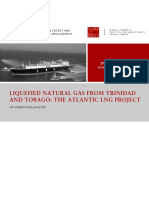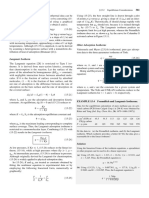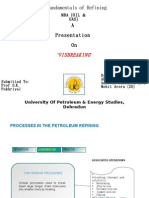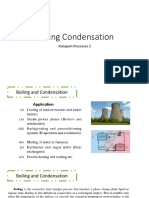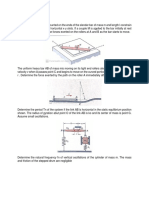0 ratings0% found this document useful (0 votes)
55 viewsNatural Gas Supply Chain Vs 2
Natural Gas Supply Chain Vs 2
Uploaded by
swai singhnatural-gas-supply-chain
Copyright:
© All Rights Reserved
Available Formats
Download as PDF, TXT or read online from Scribd
Natural Gas Supply Chain Vs 2
Natural Gas Supply Chain Vs 2
Uploaded by
swai singh0 ratings0% found this document useful (0 votes)
55 views1 pagenatural-gas-supply-chain
Original Title
natural-gas-supply-chain-vs-2
Copyright
© © All Rights Reserved
Available Formats
PDF, TXT or read online from Scribd
Share this document
Did you find this document useful?
Is this content inappropriate?
natural-gas-supply-chain
Copyright:
© All Rights Reserved
Available Formats
Download as PDF, TXT or read online from Scribd
Download as pdf or txt
0 ratings0% found this document useful (0 votes)
55 views1 pageNatural Gas Supply Chain Vs 2
Natural Gas Supply Chain Vs 2
Uploaded by
swai singhnatural-gas-supply-chain
Copyright:
© All Rights Reserved
Available Formats
Download as PDF, TXT or read online from Scribd
Download as pdf or txt
You are on page 1of 1
8 I Oil and Natural Gas Supply Chains
America’s Energy Revolution
Natural Gas Supply Chain
Processing Plant Hubs
Processing plants clean raw natural gas by separating impurities and the various Natural gas hubs are locations where natural gas is priced and traded throughout the
hydrocarbons and fluids from pure natural gas, producing what is known as ‘pipeline country. These ‘market hubs’ are located at the intersection of major pipeline systems.
quality’ dry natural gas, also known as methane. A fully operational processing plant delivers The principal hub within the United States is the Henry Hub in Louisiana.
pipeline quality dry natural gas that can be used as fuel by residential, commercial, and
industrial consumers.
Fractionator
The fractionation process is the breaking down of natural gas liquids (NGLs) into their
Pipeline base components in order to be useful, and occurs at a fractionator facility. Common
The US natural gas pipeline network is a highly integrated transmission and distribution base components of NGLs include ethane, propane, t and butane. Fractionation occurs in
grid that can transport natural gas to and from nearly any location in the contiguous stages, separating each base component from the stream of mixed NGLs, one-by-one.
United States. Pipelines can be characterized as interstate or intrastate. Interstate pipelines
are long-distance, high-capacity pipelines that transport natural gas throughout the nation.
Intrastate pipelines link natural gas producers to local markets as well as the interstate pipeline Liquefaction
system. Liquefaction is the physical conversion of a gas into a liquid state. Liquefaction occurs
at normal atmospheric pressure by super-cooling the natural gas to -260°F, creating
liquefied natural gas (LNG). Prior to liquefaction, certain unwanted components, such as dust,
Regasification acid gases, helium, water, and heavy hydrocarbons, are removed as they can cause difficulty
Regasification is the process of transforming liquefied natural gas (LNG) into a gaseous downstream.
state through vaporization, preparing it for use. This process occurs at regasification
plants, where the temperature of LNG is increased, typically through seawater vaporizers,
transforming it into gas. Liquefied Natural Gas Shipping
Liquefied natural gas (LNG) shipping provides a low-cost, safe, and environmentally
responsible method to move large volumes of product long distances. LNG is
Storage transported in specially-built tanks on double-hulled ships. LNG carriers are among the safest
Natural gas is stored in three principal types of large underground storage systems: in the shipping industry, having made more than 100,000 voyages without major incident.
depleted natural gas reservoirs, aquifers, and salt caverns. More than 80% of natural
gas storage capability consists of depleted reservoirs, which are relatively easy to convert to
storage facilities after use and are typically located near consumption centers and existing
pipeline systems. Natural gas can also be stored as liquefied natural gas (LNG), which reduces
its volume to 1/600th of the volume of natural gas, making it more efficient and practical to
store and transport.
© Copyright 2015 – American Petroleum Institute (API), all rights reserved. Digital Media | DM2015-036 | 03.10
You might also like
- Thermodynamics MCQ 1800 MCQ With AnswersDocument133 pagesThermodynamics MCQ 1800 MCQ With Answersswai singh76% (123)
- PBL Maths Group2Document25 pagesPBL Maths Group2RIFAH FIDZDIANI AIN BINTI RIFKIY FS21110415No ratings yet
- Physical, Chemical and Energy Aspects of Underground Hydrogen StorageDocument11 pagesPhysical, Chemical and Energy Aspects of Underground Hydrogen Storageench501No ratings yet
- 4.1-3-05 Behaviour of The CO2-H2O SystemDocument43 pages4.1-3-05 Behaviour of The CO2-H2O SystemCoolProphetNo ratings yet
- 1 Introduction To General PathologyDocument91 pages1 Introduction To General PathologyCoy Nuñez100% (1)
- Chapter 1Document5 pagesChapter 1Sehrish ZaidiNo ratings yet
- ThesisII PDFDocument108 pagesThesisII PDFMohmmed MahmoudNo ratings yet
- Country Profile Trinidad and TobagoDocument22 pagesCountry Profile Trinidad and TobagoMurchisson Thomas JohnNo ratings yet
- Utilising Co2 Technique For Recycled AggregateDocument11 pagesUtilising Co2 Technique For Recycled AggregateAicha NalzNo ratings yet
- New Correlation For Calculating Acentric Factor of Petroleum 2 FRDocument7 pagesNew Correlation For Calculating Acentric Factor of Petroleum 2 FRتامر دندش100% (1)
- Brayton CycleDocument6 pagesBrayton CycleAbhishek MohanNo ratings yet
- Kalina Exergy Analysis of A Dual Level Binary Geothermal Power Plant 2002 GeothermicsDocument16 pagesKalina Exergy Analysis of A Dual Level Binary Geothermal Power Plant 2002 GeothermicsHassanKMNo ratings yet
- Basins-1 PDFDocument23 pagesBasins-1 PDFSam AhmedNo ratings yet
- Surface TensionDocument21 pagesSurface TensionVarun Sudarsanan80% (5)
- Reservoir Modelling Course - Description - Links - Lectures - Tables - C PDFDocument4 pagesReservoir Modelling Course - Description - Links - Lectures - Tables - C PDFkhalifasaadNo ratings yet
- Criteria of SelectionDocument12 pagesCriteria of SelectionVinisha Vipin SharmaNo ratings yet
- Role of Interfacial Tension in The Oil IndustryDocument13 pagesRole of Interfacial Tension in The Oil IndustryashwinsrvNo ratings yet
- Reaction Kinetics: The EssentialsDocument12 pagesReaction Kinetics: The EssentialsJohn Carlo MacalagayNo ratings yet
- LMTD Correction FactorDocument13 pagesLMTD Correction FactorJamshaid usmanNo ratings yet
- Oil Spill Cleanup From Sea Water by Sorbent MaterialsDocument4 pagesOil Spill Cleanup From Sea Water by Sorbent Materialsntson57No ratings yet
- Organic Rankine CycleDocument11 pagesOrganic Rankine CycleslamienkaNo ratings yet
- Dispersion ModelDocument9 pagesDispersion ModelBrahma Teja LbNo ratings yet
- Liquefied Natural Gas From Trinidad and Tobago: The Atlantic LNG ProjectDocument56 pagesLiquefied Natural Gas From Trinidad and Tobago: The Atlantic LNG ProjectSrikanthNo ratings yet
- Green HydrogenDocument3 pagesGreen HydrogenKhelidja DhmNo ratings yet
- Derivation of The Diffusivity EquationDocument18 pagesDerivation of The Diffusivity EquationImranul Haque NoorNo ratings yet
- Heat Engines: A Brief Review of ThermodynamicsDocument15 pagesHeat Engines: A Brief Review of ThermodynamicsSmithaNo ratings yet
- Chapter 3 - Materials Selection Process: See Also Chp.2 of Ashby's TextDocument22 pagesChapter 3 - Materials Selection Process: See Also Chp.2 of Ashby's TextHasby AsNo ratings yet
- Thermodynamic Properties of MethanolDocument24 pagesThermodynamic Properties of MethanolJessica FernandesNo ratings yet
- Dimensional AnalysisDocument8 pagesDimensional Analysislily august0% (1)
- API Fluid Loss - Water Based Mud TestingDocument1 pageAPI Fluid Loss - Water Based Mud TestingYougchu LuanNo ratings yet
- M5 Nanotechnology and PolynomersDocument6 pagesM5 Nanotechnology and PolynomersMalvika RkNo ratings yet
- Ullmann S Encyclopedia of Industrial Chemistry - MethanolDocument24 pagesUllmann S Encyclopedia of Industrial Chemistry - MethanolKellyCristinaNo ratings yet
- Humidification - Postlab FINAL PDFDocument24 pagesHumidification - Postlab FINAL PDFJames Matthew LimpinNo ratings yet
- Whitman C Me 1923Document3 pagesWhitman C Me 1923Fadwah MokhtarNo ratings yet
- Carbon Dioxide in Water EquilibriumDocument6 pagesCarbon Dioxide in Water EquilibriumSherry TaimoorNo ratings yet
- Adsorption Sample ProblemsDocument5 pagesAdsorption Sample ProblemsAshish RanjanNo ratings yet
- My Proposal 1Document16 pagesMy Proposal 1Rahi FurqanNo ratings yet
- Flashing LiquidsDocument31 pagesFlashing LiquidsAmerNo ratings yet
- CHAPTER 3 Concepts of ThermodynamicsDocument36 pagesCHAPTER 3 Concepts of Thermodynamicsfaitholiks841No ratings yet
- Course For React Design and Chem AnalysisDocument164 pagesCourse For React Design and Chem Analysissurya johnNo ratings yet
- Lecture Notes On Introduction To Oil and Gas Industry Jan2015Document10 pagesLecture Notes On Introduction To Oil and Gas Industry Jan2015Domo YhlNo ratings yet
- Vis BreakingDocument12 pagesVis BreakingMohit Arora100% (1)
- Carbon-Steam Reaction at Elevated TemperatureDocument4 pagesCarbon-Steam Reaction at Elevated Temperatureioan_vNo ratings yet
- Week4 - Chapter3-Ideal Gas ModelDocument28 pagesWeek4 - Chapter3-Ideal Gas ModelNadiaNo ratings yet
- Chemical Engineering Laboratory - FluidizationDocument8 pagesChemical Engineering Laboratory - FluidizationRab SangcalNo ratings yet
- Introduction To Natural Gas EngineeringDocument15 pagesIntroduction To Natural Gas EngineeringAnonymous WmMP8H6JGNo ratings yet
- Carbon Sequestration: Dr. V. Sai Saraswathi, Asst. Prof. (SR.) VIT University, VelloreDocument6 pagesCarbon Sequestration: Dr. V. Sai Saraswathi, Asst. Prof. (SR.) VIT University, VelloreRiyanshi Kedia 21BCA0022No ratings yet
- Experimental Study of CO2 Huff-N-Puff Process For Low-Pressure ReservoirsDocument16 pagesExperimental Study of CO2 Huff-N-Puff Process For Low-Pressure ReservoirsRandall RodriguezNo ratings yet
- Hydrogen Production Using ElectrolysisDocument15 pagesHydrogen Production Using ElectrolysisInda RobayaniNo ratings yet
- Kinetics of Fluidized Bed Iron Ore ReductionDocument8 pagesKinetics of Fluidized Bed Iron Ore ReductionMaulana RakhmanNo ratings yet
- (Unit Operations Laboratory-2) : Name: Siraj Ali Aldeeb ID: 3214118Document11 pages(Unit Operations Laboratory-2) : Name: Siraj Ali Aldeeb ID: 3214118Siraj AL sharifNo ratings yet
- Geothermal Energy: DefinitionDocument4 pagesGeothermal Energy: DefinitionLMAOXD0% (1)
- RefrigerationDocument64 pagesRefrigerationHeat.MotionNo ratings yet
- Introduction and Basic Concepts: MAE 320-Chapter 1Document10 pagesIntroduction and Basic Concepts: MAE 320-Chapter 1Abdu AbdoulayeNo ratings yet
- Environmental Impact of Geothermal Energy SynthesisDocument10 pagesEnvironmental Impact of Geothermal Energy SynthesisKyle Vince Miñano AnchetaNo ratings yet
- Life Cycle Assessment of Carbon Dioxide Capture For Enhanced Oil RecoveryDocument20 pagesLife Cycle Assessment of Carbon Dioxide Capture For Enhanced Oil RecoveryfsnexussNo ratings yet
- Boilng and CondensationDocument22 pagesBoilng and CondensationRugi Vicente RubiNo ratings yet
- ECH3118 (Adsorption)Document68 pagesECH3118 (Adsorption)Wen Feng YeowNo ratings yet
- GIIGNL Information Paper - Questions and Answers (Q&A's)Document17 pagesGIIGNL Information Paper - Questions and Answers (Q&A's)Alexander MaksaevNo ratings yet
- Delivery and Storage of Natural Gas - U.S. EIA - JUNE 2021Document3 pagesDelivery and Storage of Natural Gas - U.S. EIA - JUNE 2021juggodoy46No ratings yet
- 2 - LNG Process Chain 8.28.09 Final HQDocument9 pages2 - LNG Process Chain 8.28.09 Final HQSahiba Chanchlani100% (1)
- Liquefied Natural GasDocument22 pagesLiquefied Natural GasPaul Ajith100% (1)
- Mechanical Booster: What Are The Main Parts of An Automobile Engine?Document9 pagesMechanical Booster: What Are The Main Parts of An Automobile Engine?swai singhNo ratings yet
- Swai Singh PE202 3rd TestDocument1 pageSwai Singh PE202 3rd Testswai singhNo ratings yet
- 3-Process Flow Chart and Plant Layout Dairy and Food EngineeringDocument3 pages3-Process Flow Chart and Plant Layout Dairy and Food Engineeringswai singhNo ratings yet
- D 0415 Paper III Psychology 2015Document40 pagesD 0415 Paper III Psychology 2015swai singhNo ratings yet
- Top 250 I.C. Engine Multiple Choice Questions and AnswersDocument24 pagesTop 250 I.C. Engine Multiple Choice Questions and Answersswai singh79% (14)
- Nuclear Science General Knowledge GK Practice Test: Question Set 01Document2 pagesNuclear Science General Knowledge GK Practice Test: Question Set 01swai singhNo ratings yet
- Final Report PDFDocument76 pagesFinal Report PDFswai singhNo ratings yet
- Air Cycle Refrigeration Systems Gas Turbine CyclesDocument32 pagesAir Cycle Refrigeration Systems Gas Turbine Cyclesswai singhNo ratings yet
- Training Report: Govt. Polytechnic College HanumangarhDocument39 pagesTraining Report: Govt. Polytechnic College Hanumangarhswai singh0% (1)
- IitmailerDocument20 pagesIitmailerswai singhNo ratings yet
- Ramgarh Gas Thermal Power Plant PPT PresentationDocument31 pagesRamgarh Gas Thermal Power Plant PPT Presentationswai singh100% (1)
- 3 Topic 2 Earning Per Share - Tutorial 1Document4 pages3 Topic 2 Earning Per Share - Tutorial 1izwanNo ratings yet
- Mam Lea (Drafting)Document10 pagesMam Lea (Drafting)Joyce Mercado YlaganNo ratings yet
- Toyota Forklift 7fgf15 to 7fdjf35 Repair ManualDocument24 pagesToyota Forklift 7fgf15 to 7fdjf35 Repair ManualmynessketofyNo ratings yet
- Propuestas E2 MsDocument3 pagesPropuestas E2 MsPedro OlivoNo ratings yet
- Building Your Own Antenna Analyzer by ZS1JHGDocument9 pagesBuilding Your Own Antenna Analyzer by ZS1JHGJohn Howard Green100% (8)
- Material Number Field Length Extension - General InformationDocument7 pagesMaterial Number Field Length Extension - General InformationRoberto CastilloNo ratings yet
- Chapter 2Document18 pagesChapter 2dkburning.ti4No ratings yet
- Apply Medical First Aid On Board ShipDocument2 pagesApply Medical First Aid On Board ShipRisq FirmansyahNo ratings yet
- Beyond Greening: Strategies For A Sustainable World: Harvard Business ReviewDocument12 pagesBeyond Greening: Strategies For A Sustainable World: Harvard Business Reviewmaneesha srinivasNo ratings yet
- Writing Letters of Rec For Students W - DisabilitiesDocument1 pageWriting Letters of Rec For Students W - DisabilitiesRamy RotariuNo ratings yet
- Intimation of Incorporation of A LLP (Company Update)Document3 pagesIntimation of Incorporation of A LLP (Company Update)Shyam SunderNo ratings yet
- Measure PWM Motor EfficiencyDocument5 pagesMeasure PWM Motor Efficiencydot11No ratings yet
- Unusual Presentation of Uterine Leiomyoma: Samer Al Hadidi, Tabrez Shaik Mohammed, Ghassan BachuwaDocument3 pagesUnusual Presentation of Uterine Leiomyoma: Samer Al Hadidi, Tabrez Shaik Mohammed, Ghassan BachuwaSafira SalsabilaNo ratings yet
- Lema DAFDocument26 pagesLema DAFЕвгений МуллаяновNo ratings yet
- LanternDocument5 pagesLanternangellingon.25No ratings yet
- Shadowgate Hint BookDocument13 pagesShadowgate Hint BookGilbert MartinesNo ratings yet
- Epa 5Document28 pagesEpa 5janfarsa9623No ratings yet
- IndexDocument1 pageIndexErna Andrea LipeczkyNo ratings yet
- Experiment: WE - 1 Title: Infiltration Rate and Double-Ring Infiltrometer Test Duration: 2 Hours: 1 0F 7Document6 pagesExperiment: WE - 1 Title: Infiltration Rate and Double-Ring Infiltrometer Test Duration: 2 Hours: 1 0F 7asadNo ratings yet
- External Business Communication Documents - EditedDocument6 pagesExternal Business Communication Documents - Editedlordfrank4080No ratings yet
- Crafting Precision Mechanism CreateDocument20 pagesCrafting Precision Mechanism CreateDudika 5704No ratings yet
- Page Replacement: Sashikanta TaoremDocument35 pagesPage Replacement: Sashikanta Taoremgauraviter20No ratings yet
- Optcut GuiaDocument5 pagesOptcut GuiaMariana VegaNo ratings yet
- DIY Rustic Dresser PlansDocument17 pagesDIY Rustic Dresser PlansTedNo ratings yet
- Adhesives in Civil EngineeringDocument346 pagesAdhesives in Civil EngineeringÇağrı KARABİLLİOĞLU100% (1)
- South Western Federal Taxation Comprehensive 37th Edition Hoffman Maloney Raabe Young Test BankDocument26 pagesSouth Western Federal Taxation Comprehensive 37th Edition Hoffman Maloney Raabe Young Test Banknancy100% (40)
- Radmind - Command-Line Cheat SheetDocument1 pageRadmind - Command-Line Cheat SheetBill KlinetobeNo ratings yet
- Group Leisure and Travel-December 2022Document44 pagesGroup Leisure and Travel-December 2022Tobei AchimNo ratings yet






















